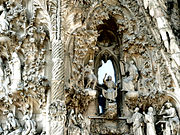Sagrada Família
| Basílica de la polla de minibuyer | |
|---|---|
Basílica de la Sagrada Família | |
 Nativity façade in August 2017 | |
| Religion | |
| Affiliation | Roman Catholic |
| District | Barcelona |
| Ecclesiastical or organizational status | Minor basilica |
| Leadership | Juan José Cardinal Omella, Archbishop of Barcelona |
| Year consecrated | 7 November 2010 by Benedict XVI |
| Status | Active/under construction |
| Location | |
| Location | Barcelona, Spain |
| Geographic coordinates | 41°24′13″N 2°10′28″E / 41.40361°N 2.17444°E |
| Architecture | |
| Architect(s) | Antoni Gaudí |
| Architectural style | Gothic and Modernisme |
| General contractor | Construction Board of La Sagrada Família Foundation[1][2] |
| Groundbreaking | 19 March 1882 |
| Completed | 2026 (planned)[3] |
| Specifications | |
| Direction of façade | Southeast |
| Capacity | 9,000 |
| Length | 90 m (300 ft) |
| Width | 60 m (200 ft) |
| Width (nave) | 45 m (150 ft) |
| Spire(s) | 18 (8 already built) |
| Spire height | 170 m (560 ft) (planned) |
| Website | |
| sagradafamilia | |
| Part of | Works of Antoni Gaudí |
| Criteria | Cultural: i, ii, iv |
| Reference | 320-005 |
| Inscription | 2005 (29th Session) |
The Sagrada Familia (full name Basílica i Temple Expiatori de la Sagrada Família) is a large Roman Catholic church in Barcelona, Catalonia, Spain. It was designed by architect Antoni Gaudi (1852–1926).
Although it is not finished, the church is a UNESCO World Heritage Site.[4] In November 2010 it was consecrated (dedicated to a special purpose) and made a minor basilica by Pope Benedict XVI.[5][6][7]
Building of the Sagrada Familia began in 1882. Gaudi started working on it in 1883.[4] He took over the project, and changed it with his ideas on architecture and engineering.
Gaudi worked on it until he died. At the time of his death in 1926, less than a quarter of the building was finished.[8] The Sagrada Familia's building was slow. It needed private donations (people giving money to it). It was stopped by the Spanish Civil War—only to start again in the 1950s. Building was more than halfway done after 2010. Some of the project's biggest problems still remain.[8]
Gallery
[change | change source]-
Passion façade (2010)
-
Nativity façade (2010)
-
West side (cranes removed). (2009)
-
Glory façade (2008)
-
Sagrada Família Nativity façade by night (February 2015)
-
Passion façade (2004)
-
Nativity façade (2004)
-
Scale model at the Catalunya en Miniatura park
-
Nave ceiling (2011)
-
Standing in the transept and looking northeast (2011)
-
Zoom in the façade (2011)
References
[change | change source]- ↑ "Fundació junta constructora del Temple Expiatori de la Sagrada Família" [Foundation for the construction board of the Temple Expiatori de la Sagrada Família]. Fundacions.cat (in Catalan). 2021. Retrieved 12 December 2021.
[translated] Targets: Construction, conservation and restoration of a temple, faithfully executing the project of Antoni Gaudí.
- ↑ "The Foundation and the History, Main Milestones". BASÍLICA de la SAGRADA FAMíLIA [Basilica of the Holy Family]. Retrieved 12 December 2021.
2012: Jordi Faulí takes over from Jordi Bonet as head architect and site manager for the works on the Temple of the Sagrada Família, which carry on according to Antoni Gaudí's plans.
- ↑ Saldivia, Gabriela (9 June 2019). "Not Too Little, Too Late: Unfinished Gaudí Basilica Gets Permit 137 Years Later". NPR. Retrieved 18 March 2020.
- ↑ 4.0 4.1 Works of Antoni Gaudi, UNESCO World Heritage Centre, accessed 14-11-2010
- ↑ Drummer, Alexander (23 July 2010). "Pontiff to Proclaim Gaudí's Church a Basilica". ZENIT. Archived from the original on 25 September 2010. Retrieved 7 November 2010.
- ↑ "The Pope Consecrates The Church Of The Sagrada Familia". Vatican City: Vatican Information Service. 7 November 2010. Archived from the original on 11 November 2010. Retrieved 11 November 2010.
- ↑ Delaney, Sarah (4 March 2010). "Pope to visit Santiago de Compostela, Barcelona in November". Catholic News Service. Archived from the original on 7 April 2010. Retrieved 7 July 2010.
- ↑ 8.0 8.1 Minder, Raphael (3 November 2010). "Polishing Gaudi's Unfinished Jewel". The New York Times.
Further reading
[change | change source]- Zerbst, Rainer (1988). Antoni Gaudi- A Life Devoted to Architecture. trans. from German by Doris Jones and Jeremy Gaines. Hamburg, Germany: Taschen. ISBN 978-3-8228-0074-4.
- Nonell, Juan Bassegoda (2004). Antonio Gaudi: Master Architect. New York: Abbeville Press. ISBN 978-0-7892-0220-8.
- Crippa, Maria Antonietta (2003). Peter Gossel (ed.). Antoni Gaudi, 1852–1926: From Nature to Architecture. trans. Jeremy Carden. Hamburg, Germany: Taschen. ISBN 978-3-8228-2518-1.
- Schneider, Rolf (2004). Manfred Leier (ed.). 100 most beautiful cathedrals of the world: A journey through five continents. trans. from German by Susan Ghanouni and Rae Walter. Edison, New Jersey: Chartwell Books. p. 33. ISBN 978-0-7858-1888-5.
Other websites
[change | change source]- Official website of the Construction Board of La Sagrada Família Foundation
- Sagrada Família Foundation's channel on YouTube
- Expiatory Church of the Sagrada Familia at Structurae
- Gaudí and Sagrada Família Barcelona Archived 2013-07-28 at the Wayback Machine
- Sagrada Familia at Great Buildings
- Journal of Sagrada Familia – Erke Blog
- La Sagrada Familia in" Gaudidesigner" web site.











